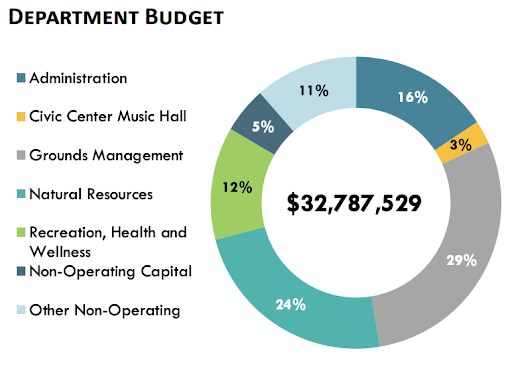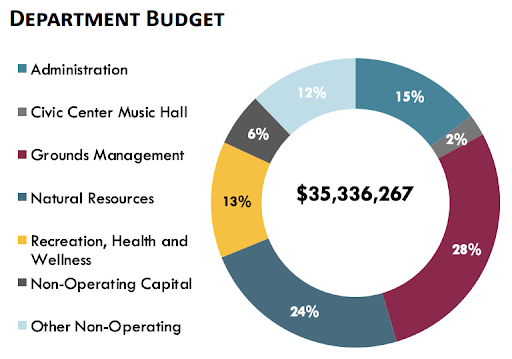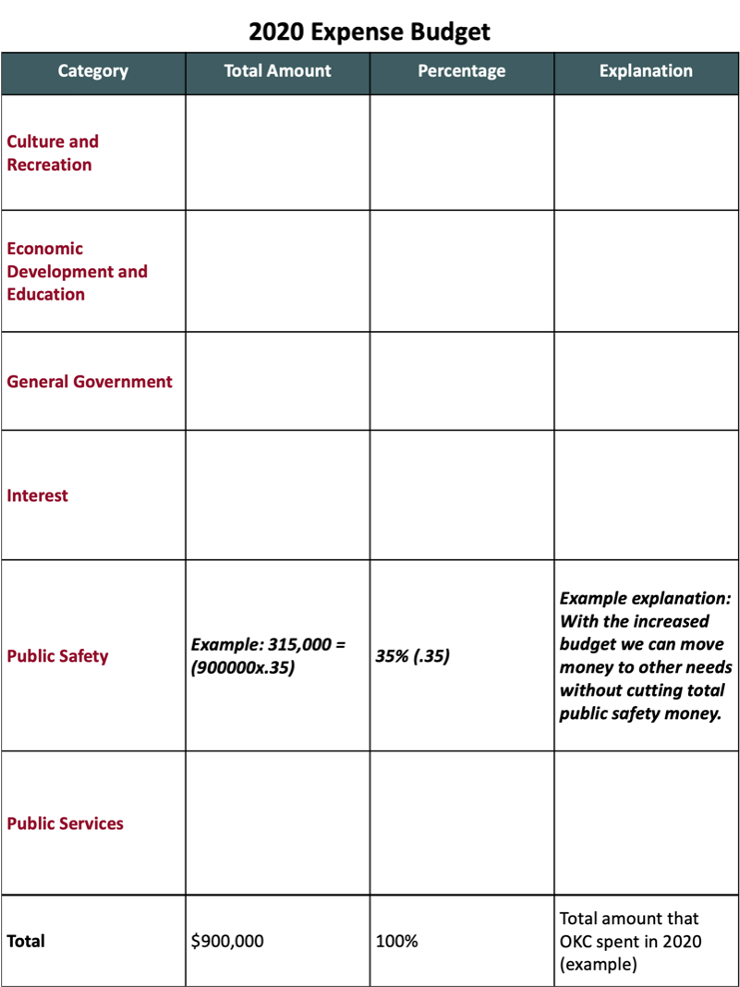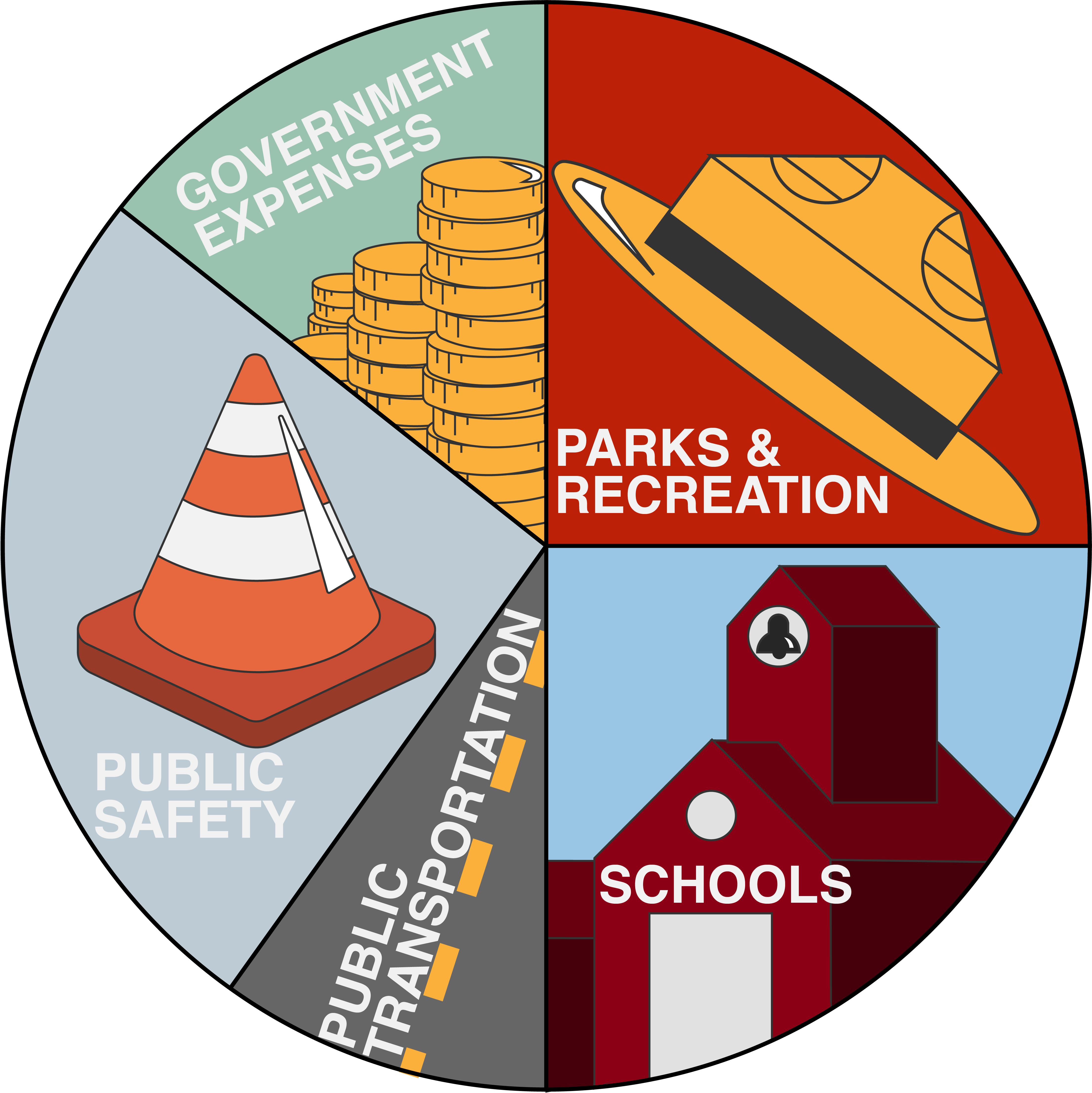Summary
Learning and understanding how cities budget their spending and plan for upcoming fiscal years is important not only to those within the Government and Public Administration career cluster but to all people. City budgets affect everyone who lives in that city, so knowing how your local government is spending money is important. In this activity, students look at Oklahoma City's spending versus budgeting and make comparisons. Students also create their own budget based on the previous year and real-life situations.
Overview
When you drive through your city or town, do you notice parks, police and fire stations, and schools? Those are there because they are funded by people like your parents, guardians, or other family members. Funds must be budgeted and spread out across the city. This is one of the jobs that workers such as mayors, city managers, and city council members must address. For city governments, a budget means a plan for how resources and money will be used. Managing a city budget is a key part of this career cluster because how money is spent affects everyone. Whether it's a public park that you visit during summer break, the library where you check out books, or the streets that you ride your bike on, these are all public property and get funded by the city budget!
No matter which government and public administration job you hold, it’s important to understand how budgets work. It’s also important to realize that different cities use their resources differently and to familiarize yourself with how your city uses its funds. For these activities, you will use Oklahoma City’s budgets, but we encourage you to research your own city’s budget and compare the two!

Materials List
Picture Your Startup Student Guide (attached)
Sheet of paper (optional)
Pen or pencil (optional)
Calculator
Internet access
What to Do
Note that you can use the attached Budgeting Your City Student Guide for the activities on this page. The Student Guide can be viewed on your computer or printed out.
Compare Oklahoma City’s 2019 and 2020 Parks and Recreation budgets.
Create your own budget.
Research more careers in the government career cluster.
Check out Oklahoma’s Association of Student Councils website.
Activity #1: Comparing Budgets
For this activity, you will be looking at the 2019 and 2020 Oklahoma City Parks and Recreation budgets to see how funds were distributed each year and compare the similarities and differences. Because parks are public property, understanding how cities budget for them is key.
Using the two graphs below, answer the questions that follow in the space provided on page 5 of the attached Student Guide (or on a separate sheet of paper). For reference, use the 2019 budget and the 2020 budget.

Oklahoma City 2019 Department Budget

Oklahoma City 2020 Department Budget
Compare and contrast the 2019 and 2020 budgets. Use the questions below to guide you.
How did the Department budgets change from 2019 to 2020?
How have the percentages changed between the two years?
How do you think the changes in Oklahoma City’s budget affect the parks?
Look at the image below—how does the actual 2019 spending compare to the 2019 budget chart above? What stands out from the breakdown chart?
Remember, the "2019 Budget Amount" is the amount that was set aside to spend on parks and recreation, and the "2019 Amount Spent" is what was actually spent. Use the questions below to help guide your answers.
How do the percentages compare from 2019’s budgeted amount to 2019’s amount spent?
How did the total spent compare to the amount budgeted?
Activity #2: Create Your Own Budget
Knowing how a budget works is an important part of the process, but knowing how to create one is even more important. Now that you have seen how Oklahoma City maps out its Parks and Recreation budget, try creating your own budget. For this activity, you will act as the Oklahoma City mayor who has been tasked with helping to create the 2020 and 2021 expense budgets. Below is an example of how you will create these budgets.
The graphic above shows Oklahoma City’s 2019 functional government expenses, which are the expenses that the government spends on public services. To complete this activity, fill in the tables that follow to create a similar budget. Using your calculator, break down each expense by percentage and total amount per category. Then, explain why you gave more, less, or an equal amount in your new budget compared to the previous year. You can do so in the space provided on pages 8-11 of the attached Student Guide or on a blank sheet of paper.
Explanation of "Sample Table of 2019’s Expenses":
Oklahoma City spent 13% of its budget on Culture and Recreation in 2019. Because we know the total amount spent in 2019 was $805,681, we can calculate the total amount per category. To do this, take the percentage per category and move the decimal point two places to the left (13% = .13, 1% = .01, etc.). Then, multiple the total amount by the decimal value. Use the sample table for help.
Example 1
For your first example, the Oklahoma City government is expecting to spend $900,000 in 2020. Break down how you should divide the funds and explain your choices. Start by thinking about the percentages that you think each category needs (i.e. Public Safety needs 35% of the budget). If you need help getting the total dollar amount per category, multiply the percentage by the total amount spent (i.e. 35% = .35 x 900,000). So if you wanted Public Safety to receive 35% of the total amount spent, the dollar amount would be .35 x 900,000 = $315,000.

Example 2
Oh, no! In 2020 Oklahoma City was hit with a pandemic and didn’t earn as much revenue as it did in years past. Due to this decline, the government isn’t able to spend as much money. Oklahoma City can spend only $700,000 for 2021. Calculate your expenses below, and explain any changes in funding because of the pandemic. Remember to explain your 2021 budget choices compared to the 2020 Expense Budget table that you completed previously.
What? So What? Now What?
Now that you have taken a deeper dive into how city and department budgets work, let’s think about what you learned, why it’s important, and what to do next. Use the What? So What? Now What? graphic organizer found on page 12 of the attached Student Guide to complete this part of the activity, or create your own using your blank sheet of paper. Use the What? So What? Now What? strategy as you work.
Materials
What? So What? Now What? page or a separate sheet of paper
Something to write with
Instructions
In the What? box, explain what you did in the two activities.
In the So What? box, describe why you did these activities, why it’s important for you to understand city budgets, and why this job matters.
In the Now What? box, consider what you can do next with this new information. How does this budget compare to your city’s? (if you don’t live in Oklahoma City, research how your city budgets spending).
Extend
Understanding how cities budget their money is just one small piece of the Government and Public Administration career cluster. To learn more about the different types of Government careers, you can visit MyNextMove’s Government section.
Cities budget their spending differently, so find your city’s budget by searching online for your city and the year's budget. Below are links to the budgets for some major cities in Oklahoma.
High School Student Council
If you are in high school and want to get more involved in hands-on government or civic activities, check out Oklahoma’s Association of Student Councils’ website. You can learn more about student council organizations and gather information about state competition conventions. Check the "Districts" tab to see whether your high school has a student council organization. Student council is a great way to boost your resume and get college scholarships while making a positive difference in your community.
Sources
City of Ardmore. (n.d.). 2019-2020 Annual budget. https://ardmorecity.org/223/Annual-Budget
City of Norman. (n.d.). Budget and reports. https://www.normanok.gov/your-government/departments/finance/budgets-and-reports
City of Tulsa. (2020). City budget. https://www.cityoftulsa.org/budget
Edmond Ok. (n.d.). Budget and reports. https://edmondok.com/302/Budget-Reports
K20 Center. (n.d.). What? So What? Now What? Strategies. https://learn.k20center.ou.edu/strategy/95
My Next Move. (2020) Careers in government. https://www.mynextmove.org/find/browse?c=93
Oklahoma Association of Student Councils (2018). www.oascok.org
Oklahoma City. (n.d.). Parks and recreation. https://www.okc.gov/home/showdocument?id=11588
Oklahoma City. (n.d.). Parks and recreation. https://www.okc.gov/home/showdocument?id=14522
The City of Oklahoma City, Oklahoma. (2019). Comprehensive annual financial report. https://www.okc.gov/home/showdocument?id=15800


